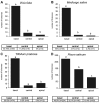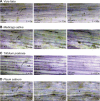Comparison of intracellular location and stimulus reaction times of forisomes in sieve tubes of four legume species
- PMID: 30111246
- PMCID: PMC6149409
- DOI: 10.1080/15592324.2018.1503493
Comparison of intracellular location and stimulus reaction times of forisomes in sieve tubes of four legume species
Abstract
Forisomes in legumes are responsible for fast sieve-element occlusion in response to injury to the vascular system. This prevents uncontrolled leakage of phloem sap and protects against invasion of pathogens. Here we compared forisomes of four different legumes (Pisum sativum, Vicia faba, Trifolium pratense and Medicago sativa) by their location (basal, central, apical) in the sieve element and reactivity to a distant heat stimulus. In each species, the majority of forisomes was located basally. Yet, we found differences in intracellular location: forisomes are distributed more evenly in the sieve elements of Pisum. After burning, basally located forisomes of the four species reacted with dispersion, followed by a spontaneous recondensation with similar reaction times. The results suggest universal forisome behaviour in fabacean species.
Keywords: Calcium; Medicago sativa; Pisum sativum; Trifolium pratense; Vicia faba; forisome; sieve elements; sieve-element occlusion.
Figures



Similar articles
-
Pea Aphid (Acyrthosiphon pisum) Host Races Reduce Heat-Induced Forisome Dispersion in Vicia faba and Trifolium pratense.Plants (Basel). 2023 May 6;12(9):1888. doi: 10.3390/plants12091888. Plants (Basel). 2023. PMID: 37176952 Free PMC article.
-
Species-Specific and Distance-Dependent Dispersive Behaviour of Forisomes in Different Legume Species.Int J Mol Sci. 2021 Jan 6;22(2):492. doi: 10.3390/ijms22020492. Int J Mol Sci. 2021. PMID: 33419062 Free PMC article.
-
Similar Intracellular Location and Stimulus Reactivity, but Differential Mobility of Tailless (Vicia faba) and Tailed Forisomes (Phaseolus vulgaris) in Intact Sieve Tubes.PLoS One. 2015 Dec 1;10(12):e0143920. doi: 10.1371/journal.pone.0143920. eCollection 2015. PLoS One. 2015. PMID: 26624625 Free PMC article.
-
Sieve element occlusion: Interactions with phloem sap-feeding insects. A review.J Plant Physiol. 2022 Feb;269:153582. doi: 10.1016/j.jplph.2021.153582. Epub 2021 Dec 5. J Plant Physiol. 2022. PMID: 34953413 Review.
-
Calcium-energized motor protein forisome controls damage in phloem: potential applications as biomimetic "smart" material.Crit Rev Biotechnol. 2015 Jun;35(2):173-83. doi: 10.3109/07388551.2013.823598. Epub 2013 Sep 11. Crit Rev Biotechnol. 2015. PMID: 24020505 Review.
Cited by
-
Pea Aphid (Acyrthosiphon pisum) Host Races Reduce Heat-Induced Forisome Dispersion in Vicia faba and Trifolium pratense.Plants (Basel). 2023 May 6;12(9):1888. doi: 10.3390/plants12091888. Plants (Basel). 2023. PMID: 37176952 Free PMC article.
-
Species-Specific and Distance-Dependent Dispersive Behaviour of Forisomes in Different Legume Species.Int J Mol Sci. 2021 Jan 6;22(2):492. doi: 10.3390/ijms22020492. Int J Mol Sci. 2021. PMID: 33419062 Free PMC article.
References
-
- Knoblauch M, van Bel AJE. Sieve tubes in action. Plant Cell. 1998;10:35–50.
-
- Nakashima J, Laosinchai W, Cui X, Brown RM Jr. New insight into the mechanism of cellulose and callose biosynthesis: proteases may regulate callose biosynthesis upon wounding. Cellulose. 2003;10:369–389. doi:10.1023/A:1027336605479. - DOI
-
- Delmer DP. Cellulose biosynthesis. Annu Rev Plant Physiol. 1987;38:259–290. doi:10.1146/annurev.pp.38.060187.001355. - DOI
Publication types
MeSH terms
Substances
LinkOut - more resources
Full Text Sources
Other Literature Sources
Miscellaneous
